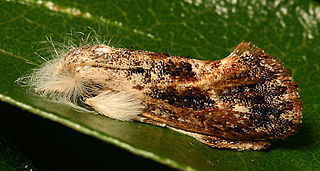| Acrolophus practica | |
|---|---|
| Scientific classification | |
| Kingdom: | Animalia |
| Phylum: | Arthropoda |
| Class: | Insecta |
| Order: | Lepidoptera |
| Family: | Acrolophidae |
| Genus: | Acrolophus |
| Species: | A. practica |
| Binomial name | |
| Acrolophus practica Meyrick, 1913 | |
Acrolophus practica is a moth of the Acrolophidae family. It is found in South America. [1]

Moths comprise a group of insects related to butterflies, belonging to the order Lepidoptera. Most lepidopterans are moths, and there are thought to be approximately 160,000 species of moth, many of which have yet to be described. Most species of moth are nocturnal, but there are also crepuscular and diurnal species.

Acrolophidae is a family of moths in the order Lepidoptera. In addition, there are about 300 species, which live in the wild only in the New World.

South America is a continent in the Western Hemisphere, mostly in the Southern Hemisphere, with a relatively small portion in the Northern Hemisphere. It may also be considered a subcontinent of the Americas, which is how it is viewed in the Spanish and Portuguese-speaking regions of the Americas. The reference to South America instead of other regions has increased in the last decades due to changing geopolitical dynamics.

